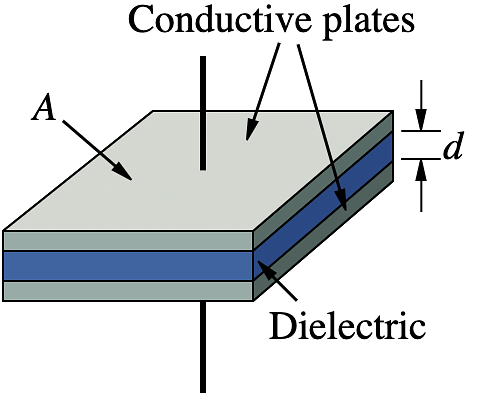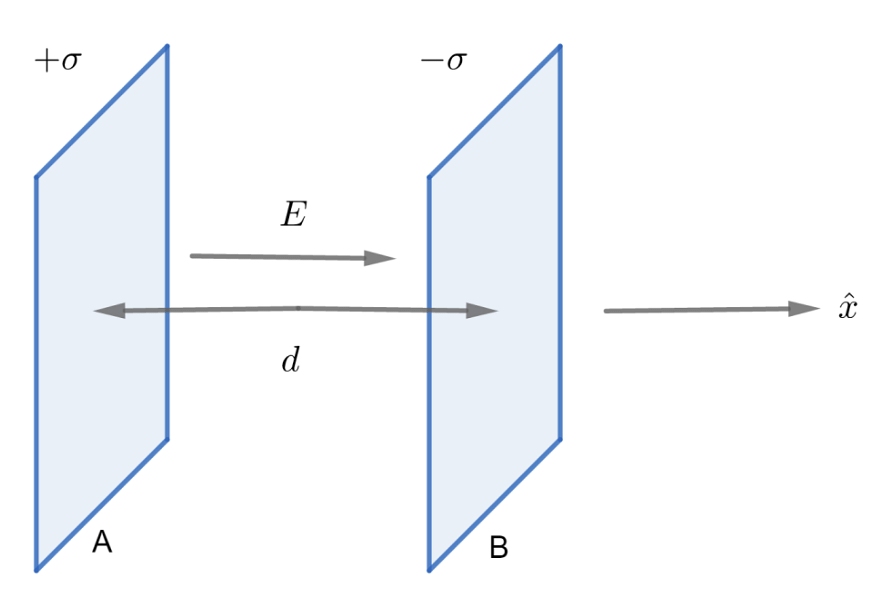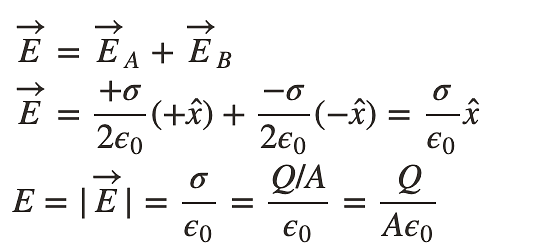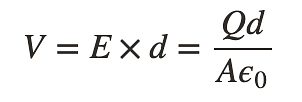Capacitors & Combination of Capacitors | Physics Class 12 - NEET PDF Download
What is a Capacitor?
- A capacitor is a two-terminal electrical device that possesses the ability to store energy in the form of an electric charge. It consists of two electrical conductors that are separated by a distance.
 Different Types of Capacitor
Different Types of Capacitor - The space between the conductors may be filled by vacuum or with an insulating material known as a dielectric. The ability of the capacitor to store charges is known as capacitance.
- Capacitors store energy by holding apart pairs of opposite charges. The simplest design for a capacitor is a parallel plate, which consists of two metal plates with a gap between them. But, there are different types of capacitors manufactured in many forms, styles, lengths, girths, and many materials.
How Does a Capacitor Work?
- For demonstration, let us consider the most basic structure of a capacitor – the parallel plate capacitor. It consists of two parallel plates separated by a dielectric. When we connect a DC voltage source across the capacitor, one plate is connected to the positive end (plate I) and the other plate to the negative end (plate II).
- When the potential of the battery is applied across the capacitor, plate I become positive with respect to plate II. At the steady-state condition, the current tries to flow through the capacitor from its positive plate to its negative plate. But it is unable to flow due to the separation of these with an insulating material.
 How Does a Capacitor Work?
How Does a Capacitor Work? - An electric field appears across the capacitor. The positive plate (plate I) accumulates positive charges from the battery, and the negative plate (plate II) will accumulate negative charges from the battery. After a point, the capacitor holds the maximum amount of charge as per its capacitance with respect to this voltage. This time span is called the charging time of the capacitor.
- When the battery is removed from the capacitor, the two plates hold a negative and positive charge for a certain time. Thus, the capacitor acts as a source of electrical energy.
- If these plates are connected to a load, the current flows to the load from Plate I to Plate II until all the charges are dissipated from both plates. This time span is known as the discharging time of the capacitor.
How do you Determine the Value of Capacitance?

- The conducting plates have some charges q1 and q2 (Usually if one plate has +q the other has –q charge). The electric field in the region between the plates depends on the charge given to the conducting plates. We also know that potential difference (V) is directly proportional to the electric field hence we can say,

- This constant of proportionality is known as the capacitance of the capacitor.
- Capacitance is the ratio of the change in the electric charge of a system, to the corresponding change in its electric potential.
- The capacitance of any capacitor can be either fixed or variable depending on their usage. From the equation, it may seem that ‘C’ depends on charge and voltage. Actually, it depends on the shape and size of the capacitor and also on the insulator used between the conducting plates.
Standard Units of Capacitance
The basic unit of capacitance is Farad. But, Farad is a large unit for practical tasks. Hence, capacitance is usually measured in the sub-units of Farads such as micro-farads (µF) or pico-farads (pF).
Most of the electrical and electronic applications are covered by the following standard unit (SI) prefixes for easy calculations:
- 1 mF (millifarad) = 10−3 F
- 1 μF (microfarad) =10−6 F
- 1 nF (nanofarad) = 10−9 F
- 1 pF (picofarad) = 10−12 F
Different Types of Capacitor
1. Capacitance of a Parallel Plate Capacitor
 Parallel Plate Capacitor
Parallel Plate Capacitor
- The parallel plate capacitor as shown in the figure has two identical conducting plates, each having a surface area A and separated by a distance d. When voltage V is applied to the plates, it stores charge Q.
- The force between charges increases with charge values and decreases with the distance between them. The bigger the area of the plates, the more charge they can store. Hence, the value of C is greater for a large value of A. Similarly, the closer the plates are, the greater the attraction of the opposite charges on them. Therefore C is greater for a smaller d.
- The charge density on the plates is given by the formula:

- When the distance of separation (d) is small, the electric field between the plates is fairly uniform and its magnitude is given by:

- As the electric field between the plates is uniform, the potential difference between the plates is given by

- Substituting the above value of V in the capacitance formula, we get

- The capacitance of a parallel plate capacitor is given by the formula

Example. Calculate the capacitance of an empty parallel-plate capacitor that has metal plates with an area of 1.00 m2, separated by 1.00 mm?
Solution: Using the formula, we can calculate the capacitance as follows:
Substituting the values, we get
2. Capacitance of a Spherical Capacitor
- Spherical capacitors consist of two concentric conducting spherical shells of radii R1 and R2. The shells are given equal and opposite charges +Q and –Q respectively. The electric field between shells is directed radially outward.
- The magnitude of the field can be obtained by applying Gauss law over a spherical Gaussian surface of radius r concentric with the shells.

- The enclosed charge is +Q, therefore

- The electric field between the conductor is given as

- Integrating
 along the radial path between the shells, we get
along the radial path between the shells, we get
- The potential difference between two conductors can be calculated using the formula

- The potential difference between the plates is
V = - (V2 - V1) = V1 - V2 - Substituting the value of V in the capacitance formula, we get

- The capacitance of a spherical capacitor is given by the equation

Example. A spherical capacitor has an inner sphere of radius 12 cm and an outer sphere of radius 13 cm. The outer sphere is earthed and the inner sphere is given a charge of 2.5 µC. The space between the concentric spheres is filled with a liquid of dielectric constant 32. Determine the capacitance of the capacitor.
Solution:
Given:
The radius of the inner sphere, r2 = 12 cm = 0.12 m
The radius of the outer sphere, r1= 13 cm = 0.13 m
Charge on the inner sphere, q = 2.5 μC = 2.5 x 10-6 C
Dielectric constant of a liquid, ∈r = 32
The capacitance of a spherical capacitor is given by the relation:
∈0 = Permittivity of free space = 8.85 x 10-12 C2 N-1 m-2
Substituting the values in the equation, we get
3. Cylindrical Capacitor
- Cylindrical capacitor consists of two co-axial cylinders of radii a and b and length l. If a charge q is given to the inner cylinder, induced change -q will reach the inner surface of the outer cylinder. By symmetry, the electric field in region between the cylinders is radially outwards.
- By Gauss's theorem, the electric field at a distance r from the axis of the cylinder is given by

- The potential difference between the cylinders is given by



or,
Factors Affecting Capacitance
➤ Dielectric
- The effect of dielectric on capacitance is that the greater the permittivity of the dielectric the greater the capacitance, likewise lesser the permittivity of the dielectric the lesser is the capacitance. Some materials offer less opposition to the field flux for a given amount of field force. Materials with greater permittivity allow more field flux, hence greater charge is collected.
➤ Plate Spacing
- The effect of spacing on the capacitance is that it is inversely proportional to the distance between the plates. Mathematically it is given as:

➤ Area of the Plates
- The effect of the area of the plate is that the capacitance is directly proportional to the area. Larger the plate area more is the capacitance value. Mathematically it is given as:
C ∝ A
What are the Applications of Capacitors?
➢ Capacitors for Energy Storage
- Since the late 18th century, capacitors are used to store electrical energy. Individual capacitors do not hold a great deal of energy, providing only enough power for electronic devices to use during temporary power outages or when they need additional power.
- There are many applications that use capacitors as energy sources and a few of them are as follows:
(i) Audio equipment
(ii) Camera Flashes
(iii) Power supplies
(iv) Magnetic coils
(v) Lasers - Supercapacitors are capacitors that have high capacitances up to 2 kF. These capacitors store large amounts of energy and offer new technological possibilities in areas such as electric cars, regenerative braking in the automotive industry and industrial electrical motors, computer memory backup during power loss, and many others.
➢ Capacitors for Power Conditioning
- One of the important applications of capacitors is the conditioning of power supplies. Capacitors allow only AC signals to pass when they are charged blocking DC signals.
- This effect of a capacitor is majorly used in separating or decoupling different parts of electrical circuits to reduce noise, as a result of improving efficiency. Capacitors are also used in utility substations to counteract inductive loading introduced by transmission lines.
➢ Capacitors as Sensors
- Capacitors are used as sensors to measure a variety of things including humidity, mechanical strain, and fuel levels. Two aspects of capacitor construction are used in the sensing application – the distance between the parallel plates and the material between them.
- The former is used to detect mechanical changes such as acceleration and pressure and the latter is used in sensing air humidity.
➢ Capacitors for Signal Processing
- There are advanced applications of capacitors in information technology. Capacitors are used by Dynamic Random Access Memory (DRAM) devices to represent binary information as bits.
- Capacitors are also used in conjunction with inductors to tune circuits to particular frequencies, an effect exploited by radio receivers, speakers, and analog equalizers.
What is a Parallel Plate Capacitor?
Parallel Plate Capacitors are formed by an arrangement of electrodes and insulating material or dielectric. A parallel plate capacitor can only store a finite amount of energy before dielectric breakdown occurs. It can be defined as:
When two parallel plates are connected across a battery, the plates are charged and an electric field is established between them, and this setup is known as the parallel plate capacitor.

Formula
The direction of the electric field is defined as the direction in which the positive test charge would flow. Capacitance is the limitation of the body to store the electric charge. Every capacitor has its capacitance. The typical parallel-plate capacitor consists of two metallic plates of area A, separated by the distance d.
The parallel plate capacitor formula is given by: C = kєºA/d
Where,
ϵo is the permittivity of space (8.854 × 10−12 F/m)
k is the relative permittivity of dielectric material
d is the separation between the plates
A is the area of plates
Derivation

Let the two plates be parallel each other each carrying a surface charge density +σ and −σ respectively. A is the area of the plates and d is the separation between them.
The electric field of a thin charged plate is given by  and is directed normally outwards from the plate. The total electric field between the two plates is given as
and is directed normally outwards from the plate. The total electric field between the two plates is given as

The potential difference between the two plates is

The capacitance is

Try Yourself!
How Capacitors are connected?
Capacitors combination can be made in many ways. The combination is connected to a battery to apply a potential difference (V) and charge the plates (Q). We can define the equivalent capacitance of the combination between two points to be: C = Q/V
Two frequently used methods of combination are:
- Parallel combination
- Series combination
Parallel Combination of Capacitors
When one plate of one capacitor is connected with one plate of the other capacitor, such combination is called parallel combination.
All capacitors have the same potential difference but different charges.
We can say that : Q1 = C1V
Q1 = Charge on capacitor C1
C1 = Capacitance of capacitor C1 
V = Potential across capacitor C1
The charge on the capacitor is proportional to its capacitance Q µ C



Where Q = Q1 + Q2 + Q3 ..............
Key Points:
- The maximum charge will flow through the capacitor of the largest value.
- Equivalent capacitance of parallel combination, Ceq = C1 + C2 + C3
- Equivalent capacitance is always greater than the largest capacitor of combination.
- Half of the energy supplied by the battery is stored in the form of electrostatic energy and half of the energy is converted into heat through resistance.
- Energy stored in the combination :





Formulae Derivation for Parallel combination:
A parallel combination of three capacitors, with one plate of each capacitor connected to one side of the circuit and the other plate connected to the other side, is illustrated in Figure.

Since the capacitors are connected in parallel, they all have the same voltage V across their plates. However, each capacitor in the parallel network may store a different charge. To find the equivalent capacitance 𝐶𝑝 of the parallel network, we note that the total charge Q stored by the network is the sum of all the individual charges:
𝑄 = 𝑄1 + 𝑄2 + 𝑄3
On the left-hand side of this equation, we use the relation 𝑄 = 𝐶𝑝𝑉, which holds for the entire network. On the right-hand side of the equation, we use the relations
𝑄1 = 𝐶1𝑉 , 𝑄2 = 𝐶2𝑉 , and 𝑄3 = 𝐶3𝑉 for the three capacitors in the network.
In this way we obtain 𝐶𝑝𝑉 = 𝐶1𝑉 + 𝐶2𝑉 + 𝐶3𝑉.
This equation, when simplified, is the expression for the equivalent capacitance of the parallel network of three capacitors: 𝐶𝑝 = 𝐶1 + 𝐶2 + 𝐶3
This expression is easily generalized to any number of capacitors connected in parallel in the network.
Series Combination of Capacitors
When initially uncharged capacitors are connected as shown, then the combination is called series combination

All capacitors will have the same charge but different potential difference across them.
We can say that 
V1 = potential across C1
Q = charge on positive plate of C1
C1 = capacitance of capacitor similarly

V1 : V2 : V3 = 
We can say that potential difference across capacitor is inversely proportional to its capacitance in series combination.

Key Points:
- In a series combination, the smallest capacitor gets maximum potential.
-
 ,
,  ,
,  Where V = V1 + V2 + V3
Where V = V1 + V2 + V3 - Equivalent Capacitance:
Equivalent capacitance of any combination is that capacitance which when connected in place of the combination stores the same charge and energy as that of the combination
In series: ........................
........................ - In series, the combination equivalent is always less than the smallest capacitor of the combination.
- Half of the energy supplied by the battery is stored in form of electrostatic energy and half of the energy is converted into heat through resistance.
- Energy stored in the combination:
Ucombination = Ucombination =
Ucombination =  The energy supplied by the battery in charging the combinationUbattery = Q × V = Q .
The energy supplied by the battery in charging the combinationUbattery = Q × V = Q .  =
= 

Formulae Derivation for Series combination:
Let the capacitance of each capacitor be C1, C2 and C3 and their equivalent capacitance is Ceq.
As these capacitors are connected in series, thus charge across each capacitor is same as Q. When some electrical components, let say 3, are connected in series with each other, the potential difference of the battery V gets divided across each component as
V1, V2 and V3 as shown in the figure.

∴ V = V1 + V2 + V3
Using V = Q/C

Equivalent capacitance for series combination = 
In general, 
Solved Examples:
Example 1: Find charge on each capacitor.

Sol. Charge on C1 = C1V1 = 2 × (20 - 5)μC

= 30 μC
Charge on C2 = C2V2 = 2 × (20 - (-10))μC
= 60 μC
Charge on C3 = C3V3 = 4 × (20 - 10)μC
= 40 μC
Example 2: Find charge on each capacitor.

Sol. Charge on C1 = (x - 10) C1
Charge on C2 = (x - 0) C2
Charge on C3 = (x - 20) C3
Now from charge conservation at node x

(x - 10)C1 (x - 0)C2 (x - 20)C3 = 0
⇒ 2x - 20 2x 4x - 80 = 0
⇒ x = 25 Therefore
so 



Example 3: In the given circuit find out the charge on each capacitor. (Initially they are uncharged)


Sol. Let potential at A is 0, so at D it is 30 V, at F it is 10 V and at point G potential is -25V. Now apply Kirchhoff's Ist law at point E. (total charge of all the plates connected to 'E' must be same as before i.e. 0)
Therefore, (x - 10) + (x - 30) 2 +(x 25) 2 = 0
5x = 20
x = 4
Final charges :
Q2mF = (30 - 4) 2 = 52 mC
Q1mF = (10 - 4) = 6 mC
Q2mF = (4 - (-25)) 2 = 58 mC

Example 4:

Find voltage across capacitor C1.
Sol.

Now from charge conservation at node x and y
for x
(x - 4)C1 + (x - 2)C2 + (x - y)C3 = 0 ⇒
2(x - 4) + 2(x - 2) (x - y) 2 = 0
6x - 2y - 12 = 0 .....(1)
For y
(y - x)C3 + [y -(-4)]C4 (y - 0)C5 = 0 ⇒ (y - x)2 (y 4) 2 y 2 = 0
= 6y - 2x 8 = 0 .....(2)
eq. (1) & (2)
y = - 3 Therefore
x = 7 Therefore
So potential difference = x - y = 

Example 5: Three initially uncharged capacitors are connected in series as shown in circuit with a battery of emf 30V. Find out following :
(i) charge flow through the battery,
(ii) potential energy in 3 mF capacitor.
(iii) Utotal in capacitors
(iv) heat produced in the circuit
Sol. 
Ceq = 1 μF.
(i) Q = Ceq V = 30 μC
(ii) charge on 3μF capacitor = 30 μC
energy =  =
=  = 150 μJ
= 150 μJ
(iii) Utotal =  = 450 μJ
= 450 μJ
(iv) Heat produced = (30 μC) (30) - 450 μJ = 450 μJ
Example 6: Two capacitors of capacitance 1 mF and 2mF are charged to potential difference 20 V and 15 V as shown in figure. If now terminal B and C are connected together terminal A with positive of battery and D with negative terminal of battery then find out final charges on both the capacitor.



Now applying kirchhoff voltage law

- 40 - 2q - 30 - q = - 60
3q = - 10
Charge flow = -  μC.
μC.
Charge on capacitor of capacitance 1μF = 20 q = 
Charge on capacitor of capacitance 2μF = 30 q = 
|
105 videos|425 docs|114 tests
|
FAQs on Capacitors & Combination of Capacitors - Physics Class 12 - NEET
| 1. What is a capacitor? |  |
| 2. What are the different types of capacitors? |  |
| 3. What are the applications of capacitors? |  |
| 4. How are capacitors connected in circuits? |  |
| 5. What is the formula for calculating the capacitance of a parallel plate capacitor? |  |

|
Explore Courses for NEET exam
|

|











 along the radial path between the shells, we get
along the radial path between the shells, we get





 ,
,  ,
,  Where V = V1 + V2 + V3
Where V = V1 + V2 + V3 ........................
........................ Ucombination =
Ucombination =  The energy supplied by the battery in charging the combinationUbattery = Q × V = Q .
The energy supplied by the battery in charging the combinationUbattery = Q × V = Q .  =
= 



















